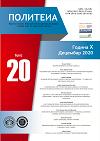Medijalni obrt i estetika ekscesa
Medial Turn and Aesthetics of Excess
Author(s): Ivana Stojanović PrelevićSubject(s): Media studies, Aesthetics, Social Philosophy, Social development
Published by: Fakultet političkih nauka Univerziteta u Banjoj Luci
Keywords: Media; aesthetics; medial turn; aesthetics of excess;
Summary/Abstract: The evolution of media system had an impact on human forms of communication and the relationship between human beings and reality (Schmidt,2013). In addition, the relationship between the media and human beings has undergone changes. Human beings have become an instrument of the media, rather than its goal, which is opposite to deontological ethics based on the respect of human dignity. After transition from communicativeness to mediality, one can talk about the mediatization of mind, which consists of the development of new tools: computers (Hudzik, 2018) and technocentrism (Krämer, 1989). The medial turn means that the form is more important than the content, which is reflected in the media aesthetics, also called (after the media turn occurred) the aesthetics of excess. (Lipovecki, Seroa 2013). The author explains the medial turn phenomenon and explores the nature of the corresponding media aesthetics. A descriptive method is used. Given that visual culture is widespread, due to the development of technologies and possibilities of manipulating and using different effects, the focus of media contents is more on the image, which goes in favor of the hypothesis that contemporary society is the society of images, not of the text (Mirzoef, 1983). This is also the main hypothesis in the paper, which is confirmed in the conclusion.
Journal: Politeia - Naučni časopis Fakulteta političkih nauka u Banjoj Luci za društvena pitanja
- Issue Year: 11/2021
- Issue No: 22
- Page Range: 25-35
- Page Count: 11
- Language: Serbian

